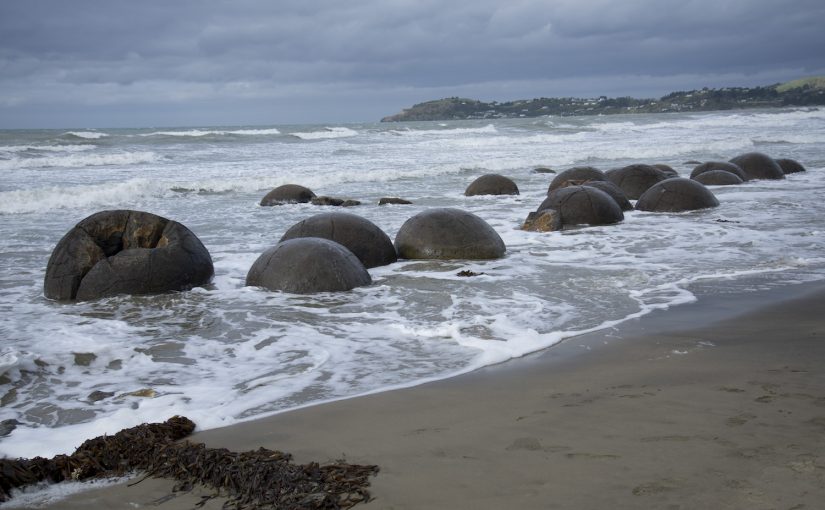To continue our road trip through New Zealand’s South Island we needed a new destination. We chose the city of Dunedin (pronounced Done-Eden) in the Province of Otago on the Southeast Coast. We had read about a protected Albatross colony near that city, the only one in the world that could be approached without water wings. It would serve us as a fine point of interest. The Albatross had intrigued us ever since we had read Coleridge’s The Rime of the Ancient Mariner years ago in school. We had never seen one, a fact not surprising since this strange bird spends almost its entire life at sea.
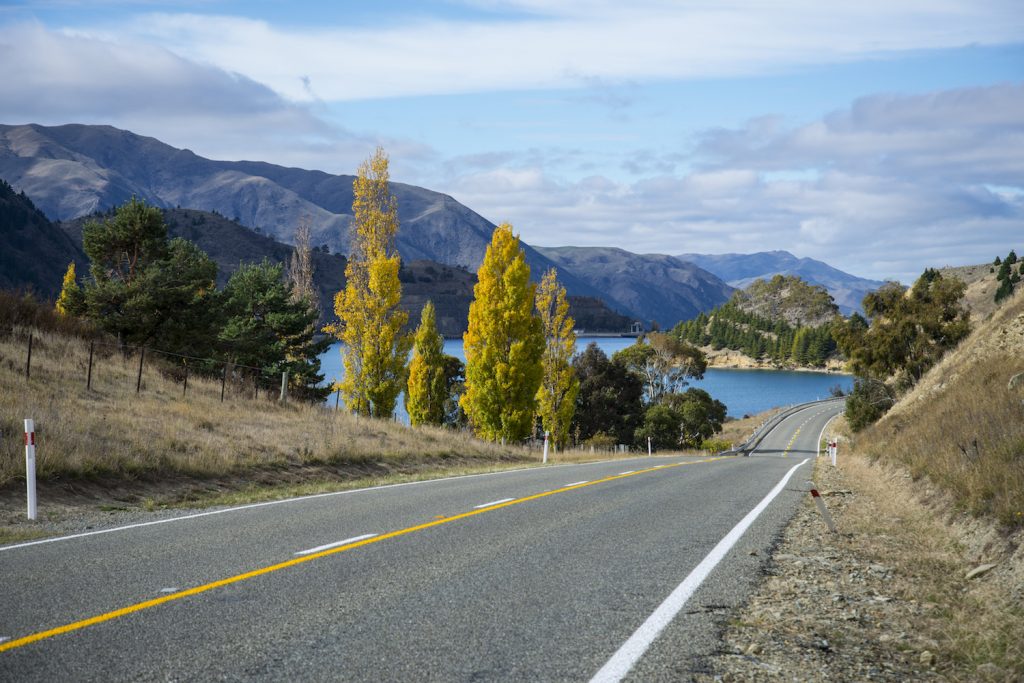
To reach Dunedin from Hokitika would involve a two-day drive south and east across the island. Once again, we followed friend Ian’s suggested route through many more kilometers of gorgeous landscape
We got an early start on the first day, happy to be leaving the Beachfront Hotel where our room was small and the bathroom smaller. I skipped shaving that day because the sink was so tiny that I feared getting water and shaving cream all over the floor and myself.

The day’s driving challenge was along Route 73 through the mountainous spine of the island known as the Southern Alps. It was cloudy with light rain at times, but the drive could have been a lot worse. Even under these conditions, the scenery was beautiful. To Kay’s annoyance, I couldn’t help myself from stopping the car from time to time on some precipice to take a photo.
After Starvation Point and Devil’s Corner we arrived at Arthur’s Pass and parked in front of a youth hostel where shivering backpackers stood waiting for a bus. Inside a café we drank coffee and read about Keas, the parrots that are not shy around humans and take what they can get. On a wall, we read this warning:
“Please protect your food and belongings from the Keas. No replacements or refunds will be given for stolen food.”
The drive down the mountain and into the town of Geraldine was a breeze. We stopped there for a snack and on impulse went to see the local Vintage Car and Machinery Museum. We hoped the collection would differ from ones we’d seen in the U.S., and we were not disappointed. The enthusiastic, elderly gent who welcomed us explained that the museum was his club’s creation and that many of the cars belonged to the members. Although there were tractors and other agricultural machinery spread around several large sheds, it was the automobiles that interested us the most. As we suspected, there were many vintage British makes: Vauxhalls, Morrises, Holdens, Triumphs, and Jaguars. There was even a Riley, a make we had never heard of. I was surprised to encounter a couple of MGs, not the sports cars, but MG sedans or what the British call saloons.
There were some American nameplates too, although the Fords tended to be British versions, quite different from their American counterparts. The same is true for a couple of Valiants, larger and roomier than those I remember from the early 1960s.
If there was a single standout, it had to be the unique creation of John Britten, he of the world’s fastest motorcycle. When Britten was still quite young he restored a junked and rusted International cab and chassis and crafted a wooden body that he called a Gypsy Wagon. It looks like a small house. Through the back door we saw a small, iron wood-burning stove, a built-in chest of drawers, and a settee that would fold into a bed. The body has wooden scallops, small stained-glass windows on the back doors, and other ornamentation inside and out. Britten was some kind of genius and a very creative mind.
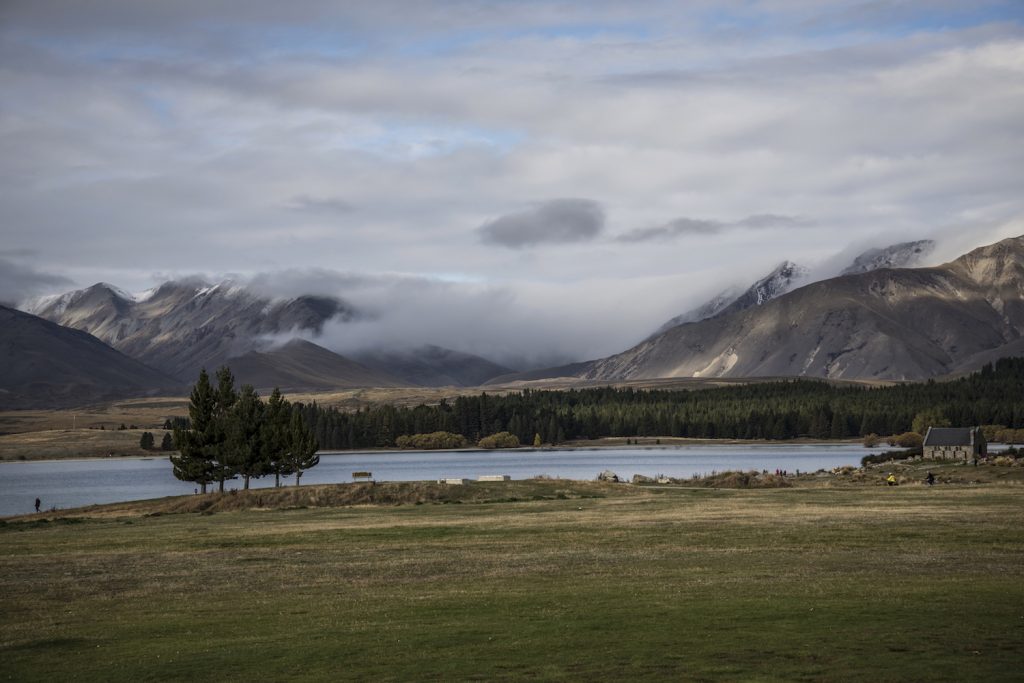
We ended the day at a scenic resort on the shore of beautiful Lake Tekapo. This lake, like many others in New Zealand, has a pristine, unspoiled appearance. Beyond our small resort community, there is no other development. Looking out of our picture window, we saw no roads, signs, or buildings. There was only a ring of trees and mountains reflected in the lake’s mirror surface.
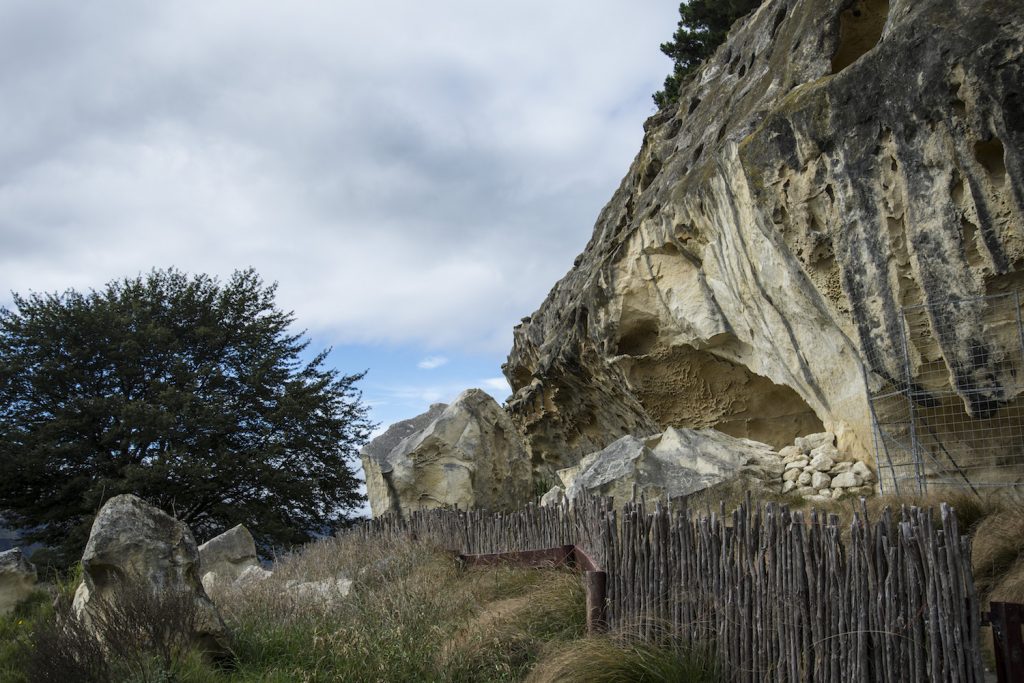
The following day we resumed our drive, stopping briefly to look at the Waitaki Power Station and some Maori rock paintings.
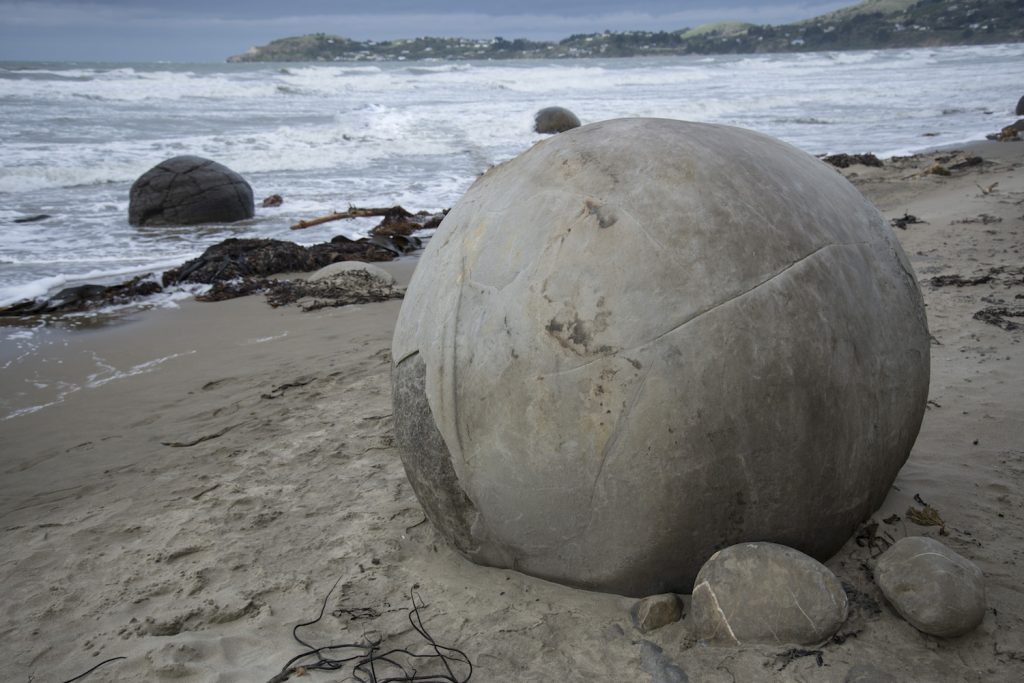
We made a longer stop on the East Coast and bucked a fierce wind along a beach to where there is a collection of almost perfectly round boulders. The Moeraki boulders are grey-colored concretions of hard, sedimentary rock that have been “exhumed from the mudstone enclosing them and concentrated on the beach by coastal erosion.” Maori myth has more colorful tales of their origin. Anyway, they are large, famous, and well worth the detour to gaze upon.

We arrived at Dunedin on that chilly afternoon and spared no time finding our motel. Our fleeting first impressions were of a city with a strong British influence. In fact, most of the prominent buildings date from England’s Edwardian years. The black-and-white façade of the railway station done in Flemish Renaissance style by an architect who worked for the railroad is striking. We love the great, old railway stations built to glorify the early days of rail travel. There’s so much romance in them.
The centerpiece of our stay in Dunedin was our visit to the Royal Albatross Centre located at the tip of the Otago Peninsula. To get there we drove along a winding shore road through a succession of small communities for at least twenty kilometers. It was slow going to say the least. At the end of the road the modern and well-appointed Albatross Centre is located just below a steep hill whose seaward face is the nesting ground for the world’s only mainland Albatross colony.

In the centre, we had to wait for the next guided tour and so had time to browse, reading facts and looking at pictures and a video of the adult birds in flight. An Albatross can live for a long time, as long as forty years. With their wings closed they look a bit like large sea gulls. It’s when they unfold their wings that they take on their unmistakable appearance. Their wings are so long they are jointed in four places, allowing them to fold next to their bodies. When deployed, those wings span more than nine feet, allowing the birds to soar at length over the sea. Although much is known about their breeding habits and their protracted adolescence in the nest, much less is known about their lives at sea.

Once they fledge and fly away, they stay gone for five years and return only to mate, incubate a single egg, and feed their offspring.

We didn’t see any adult birds during our visit. Through the large window of the hilltop observation station we looked down through binoculars at four nests containing young birds. The curious thing is that they remain in those nests day and night for several months, being fed and gaining weight. Though we didn’t see live birds in flight, we felt our visit to the Albatross Centre was a success. We learned a lot about these unusual birds and marveled, as we have repeatedly on this voyage, at the many strange and wonderful ways of nature.
Besides a couple of excellent breakfasts at Nova, an award-winning local restaurant, and a fish-and chips dinner of blue cod at a place called Best Café, in business since 1932, Dunedin held another pleasant surprise for us.
The Settlers’ Museum near the train station has been given high marks by those who judge museums. It is indeed an interesting place. In part, its mission is to serve as an archive of the 19-century men and women who came from England and Scotland to settle Otago Province. The walls of one large room are filled with studio portraits of couples in middle or old age identified by name and the name of the ship that brought them to New Zealand. Another exhibit nearby is a recreation of the narrow, low-ceilinged cabin lined with tiered bunks and a long, narrow table down the center where the immigrants slept and ate for weeks during the long sea voyage.
Other parts of the museum document how the people of the province lived during the decades of the early 20th century. All the artifacts, including clothing, household appliances, buggies, early automobiles, tramcars and even a bus are restored and in excellent visual condition. What’s more, everything is displayed with an unusual elegance that adds to its symbolic importance. Kay enjoyed watching segments of an early New Zealand TV cooking program, Here’s How. What a treat when our friend Pam showed us her autographed copy of Here’s How: Cooking with Alison Holst from 1967.
The exhibits are arranged somewhat in chronological order. Each successive gallery brought us closer to our own time. At last, we stood in a gallery filled with business machines. There were early adding machines and typewriters as well as the punch-card machines that predated computers. As for the latter, a display case contained a Mac Classic and even an iMac of the kind I used at a company where I worked toward the end of my career. And then there was an early main frame, filling a whole corner of the gallery, appearing just as it would have in the computer center of a corporation. I smiled as I thought I probably have more computing power in my Mac Air that this behemoth had in its heyday.
Dunedin was the penultimate destination on tour of New Zealand’s South Island. From there, we returned to Queenstown, dropped the rental car, and flew back to Auckland for rest and recuperation at the home of Pam and Ian. There is more to say about the Farbers in New Zealand, but it can wait.
